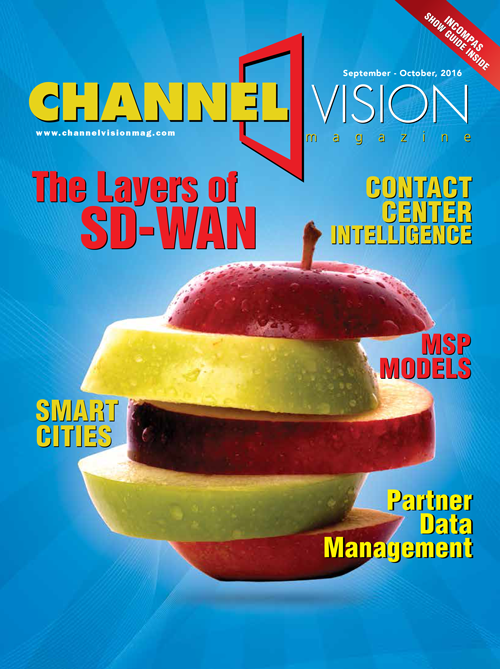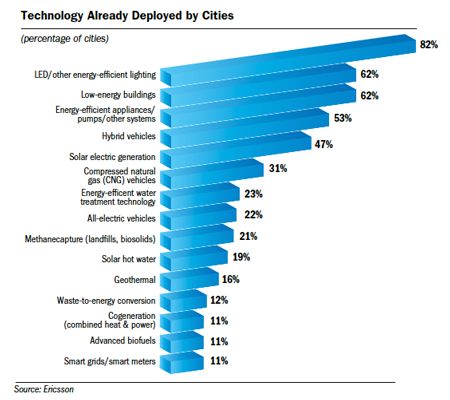Urban Renewal – Smart Cities Light Up New Frontiers of Opportunity
By: Tara Seals

The era of smart cities is upon us. Think smart lightbulbs, smart thermostats, HD video surveillance for law enforcement with facial recognition, autonomous parking meters and self-driving cars, automatic trash collection and more. And channel partners have a potentially large role to play in this rapidly growing market.
Municipalities around the globe are looking to use integrated information and communications technology (ICT) systems to better support an exploding population, improve efficiency, manage complexity and enhance revenue generation, leading to sustainable improvement in city operations and the meeting of environmental goals – not to mention more positive living for citizens.
Barcelona, for instance, widely considered the No. 1 smart city in the world, has installed noise and air quality sensors along one of its major thoroughfares, and has implemented smart streetlights, smart parking and smartphone apps for tourists to use to navigate the city’s sights. At the city’s Llevant Beach, there are 22 self-powered lighting units, including six that rely on solar and wind power. The wind-powered units can function when wind speed is relatively slow, storing up enough energy to operate as long as six days without pulling electricity from the grid.
Barcelona may lead the way, but things are getting underway with pilot programs developing worldwide. In 2014, Singapore launched its Smart Nation vision, and in September 2015 the White House announced an investment package of $160 million to stimulate smart city growth in the United States. The EU meanwhile has the “Lighthouse” project, which has designated Barcelona, Stockholm and Cologne, Germany, as pioneer cities that will provide success blueprints for replication to other towns and cities across Europe.
“National government support and funding packages are very important to encourage the growth of smart cities, as most municipal governments do not have generous budgets to make large investments in new technology,” said Roz Euan-Smith, senior analyst for smart cities at IHS.
The majority of the 400 smart city projects that research firm IHS Technology tracks are trials or small-scale deployments. But in the last two years there has been increasing interest in the sector and several countries have unveiled ambitious smart city development projects bent on addressing these goals.
The evolution of the wireless network to 5G standards will accelerate smart-city adoption. According to Ericsson, during the next five years, traffic volumes on cellular networks will be multiplied 1,000 times, and 100 times more devices will require connectivity. Some applications will demand data rates 100 times the speeds that average networks currently deliver. Some will require near-zero latency or network delay. And the entire system will work to enable battery life of 10 years for low-power IoT devices. The evolution to 5G, which is architected to support this new reality, will spur innovation, making cities more livable, secure, efficient and responsive to citizens’ needs. Carriers – and by extension, channel partners – have a critical role to play in not only providing the connectivity that acts as a bedrock for these projects but also in everything from rolling out value-added services such as analytics or device management to offering cloud-based video surveillance to police departments and providing consumer-facing apps and kiosks. At the beginning of the year AT&T, for instance, launched its smart cities framework, which is an alliance of technology partners that it will work with to develop vertically integrated solutions for specific applications, such as waste management or smart water.
RELATED: International Agents Section: LTE Unlicensed
Demonstrable Benefits
There are immense benefits on many levels for implementing smart city technology. According to Beverly Ride, head of Cloud IoT & Smart Cities at Ericsson, the example of connected light poles shows clear-cut, demonstrable ROI. Cities can improve energy savings with a smart management platform that controls lighting based on real-time conditions, not just time of day. They can also increase energy savings to an estimated 80 percent or more by connecting the light poles, versus estimated 50 percent energy savings when switching to LEDs only.

A two-and-a-half-year pilot project involving some of the world’s largest cities (New York, London, Hong Kong, Toronto and Sydney) found that combining LEDs with smart controls generated energy savings up to 85 percent higher. Further savings can be found through reduced maintenance on the longer-lasting LED bulbs.
“Making the light poles smart helps to eliminate overlighting and overspending on energy,” she explained. “And once light poles are connected, sensors can be added to detect motion, sounds (like gunshots), deliver audio announcements and monitor pollution. Digital signage (providing traffic instructions, advertising, maps, and public transportation information), video surveillance, public Wi-Fi, and even cellular sites can be added to light poles.”
Connected lighting essentially creates a backbone where these sensors can reside.
“Sharing data across various applications is critical to gaining the full benefit from each application deployed,” she said. “When data is shared and not siloed within the single application, additive value occurs for the city and its citizens. Multi-use infrastructure, such as light poles, leverages the city’s investments over a wider range of public and private uses.”
Another example of reaping secondary, even tertiary, benefits from connecting things comes from a pilot program being pioneered by Massachusetts Institute of Technology. The Senseable City Laboratory group is working on a project called Underworlds, which examines the intersection of the physical, virtual and biological. It starts with collecting sewage, filtering it and using techniques to analyze genetic material present. From there, it’s possible to identify viruses and bacteria, as well as spot specific chemicals using a technique known as mass spectrometry.
“New techniques in biology allow us to characterize bacteria and viruses leaving our bodies – our microbiome,” project director Carlo Ratti explained. “At the urban scale, we are using waste water to open up a new world of information on human health and behavior through a platform we call ‘smart sewage,’ which allows us to detect the urban microbiome. This allows near real-time urban epidemiology and understanding human health and behavior with a fine spatio-temporal resolution.”
In addition, smart sewage could impact the way non-communicable diseases are studied, because biomarkers for diseases such as obesity and diabetes can be measured at unprecedented scale.
MIT is also heading up the Trash Track project in Seattle. The city placed digital tags onto trash and then followed it as it moves through the city’s sanitation system. “We discovered many things, and one of those things is that simply by sharing information you can promote behavioral change,” Ratti said. “People involved in the project would be able to follow their trash. This prompted many of them to change their habits. One person told us, ‘I used to drink water in plastic bottles and throw them away and think that they would disappear, but I know it is not true anymore. They just go a few miles from home to a landfill. So I stopped drinking water in plastic bottles.’”
RELATED: International Agents Section: Think Global, Act Local
Challenges, and a Strong Future
Against all of the innovation, it’s important to note that there are challenges in bringing smart cities to fruition. For one, when it comes to the Internet of Things, operators are moving from a limited scope of network requirements and deployment issues to a much more complex scale and range of use cases. Whether it’s video surveillance and other high-bandwidth apps that need as close to zero latency as possible or networks of environmental sensors that transmit small amounts of information frequently and need a long battery life, IoT will be a fundamentally different story for the mobile ecosystem to support – and that presents a learning curve.
Also, the sheer complexity involved is a potential gating factor, as is the fact that new systems require new regulations. And, security will be a big issue in the IoT world considering that hacking into information systems is nothing new. Add that to the fact that low levels of operational efficiency in emerging countries and absence or lack of robust telecom and networking infrastructures in these regions are majors restraining factors for non-first world areas.
Nonetheless, the future looks very bright indeed. MarketsandMarkets said the market size of smart is estimated to grow from $312.03 billion in 2015 to $757.74 billion by 2020, representing an estimated compound annual growth rate (CAGR) of 19.4 percent for the forecast period.
Among the regions, the AsiaPacific (APAC) region is expected to grow with the highest CAGR, while Europe is expected to be the highest contributor followed by APAC, according to MarketsandMarkets. The market is in the emerging stage in the regions of Europe, APAC, Latin America, and the Middle-East and Africa (MEA). Therefore, these regions present immense scope for the development of smart cities.
VIEW ARTICLE
SUBSCRIBE TO MAGAZINE
About ChannelVision Magazine:
ChannelVision is a bi-monthly digital and print magazine, read by channel partners selling all manner of voice, data, access, managed and business services (both on premise and “in the cloud”), as well as, technology, gear, and equipment. ChannelVision is a highly focused and efficient way for service providers, hardware, and software companies to reach experienced channel partners targeting the small/medium business space. Serving a controlled circulation of providers and indirect distributors of communications, network, IT and cloud-based business services, ChannelVision is telecom’s gateway to perspective on how to adapt, what to sell, and how to sell it.










